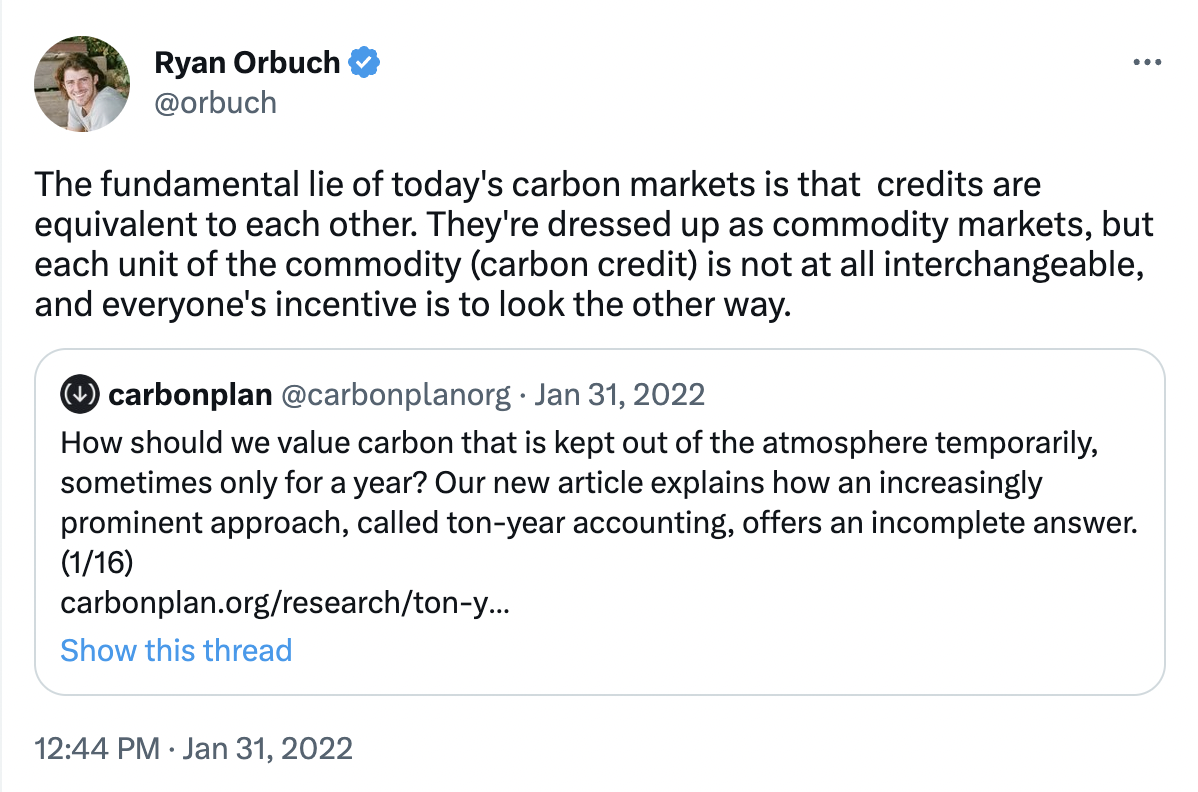The Ad Hoc Gist: We Need a Gigaton of Carbon Removal
This month's Gist is about the necessity of carbon removal to achieve our climate goals – and what's required at the federal, state and market level to accelerate its uptake with ironclad scientific credibility.
In AHG news, we welcome new senior advisors Val Jensen and Mark McVay to our ranks. We're also hiring for two roles so ping me if interested and share widely: jim@theadhocgroup.com
Enjoying the Gist? Forward to those who should subscribe.
And if there’s a topic you think we should cover or a job you’d like us to post, fire away.
Jim
We Need a Gigaton of Carbon Removal
To cap warming at 1.5°C, we need to capture and store carbon before it escapes into our atmosphere. And we need to remove what we can that’s already up there. Probably hundreds of billions of tons of it. Not as a hedge, but as a pillar of strategy. So says the Intergovernmental Panel on Climate Change, which concluded that "all analysed pathways limiting warming to 1.5°C" require carbon removal.
Because we can’t get to 1.5°C fast enough if we're only focused on electrifying buildings, transport, and industry. Those things must happen. But we're decades away from zero-carbon supply chains for steel and cement. Some buildings are too big and unwieldy (read: expensive) to electrify any time soon. And electrifying vehicles is going to take time because it’s hard– see the last Gist.
To be clear, I’m not talking about retrofitting coal and gas plants, or what we've known as Carbon Capture and Storage. Those projects may have a role, but they're also not the answer. For example, Royal Dutch Shell’s Carbon Capture facility in Alberta has since 2015 been a net emitter of carbon by 2.5 million tons.
Rather, I'm excited about the new wave of Carbon Dioxide Removal (CDR) technologies, plural. Startups are coalescing in these areas:
- Direct Air Capture (DAC): Climeworks uses giant fans to pull carbon out of the air before turning it to stone. See Rhodium Group study here. A Geophysics Professor at Columbia suggests pairing wind turbines with air capture systems to bury surplus wind power in underwater basalt rock.
- Biomass: Charm Industrial last year surpassed 5,000 tons of carbon (more than 10x what DAC technology has captured to date) with its pyrolysis process, which converts biomass such as corn stalks into a liquid which, when injected into EPA-regulated wells, solidifies for permanent storage. Elegant in its simplicity, it could also be gasified and used to decarbonize steel production, aka the high stakes table of the CDR game.
- CO2 stored in commercial concrete: CarbonCure and CarbonBuilt inject CO2 into fresh concrete, reducing the inherent carbon intensity of one of the toughest commodities to decarbonize.
- Enhanced Carbon Mineralization: Heirloom uses minerals to produce oxides that naturally bind to CO2, and then exposes the rocks to the air to soak up carbon. If this all sounds a bit Dune to you, please know I fully support its Best Picture nomination.
- Ocean CDR: Ebb Carbon has developed a modular technology that assists the ocean's natural process of absorbing CO2 and forming bicarbonate, thereby reducing ocean acidification. Project Vesta adds the mineral olivine to ocean sand, thus rendering it sensitive to carbon absorption.
Other ideas have promise but haven't been tested or deployed at any scale. Carbon Plan keeps an awesome database of known CDR project proposals for those who want to nerd out.
Stripe, Microsoft and Shopify are currently leading the way with voluntary commitments to purchase carbon removal offsets, driving enough early demand to stimulate some venture capital. But these technologies won’t scale without new federal, state and ultimately global policy intervention with, at the minimum:
- Tech neutral federal policy: Washington's most important carbon capture stimulant, an esoteric tax incentive named 45Q, was created by/for the fossil industry and effectively excludes technologies that aren’t directly connected to existing fossil infrastructure. 45Q must be revised to be technology neutral, to unleash a market for startups with superior technologies as they emerge, based on proven results. As Stripe's Hannah Bebbington put it the other day: "Stubborn on criteria, flexible on pathway."
- State fuel standard pathways and procurement: We need a decade of state-based Low Carbon Fuel Standards (LCFS)’s that include new pathways for a range of CDR technologies. California, Washington and Oregon are moving in the right direction. State procurement policies could also help; last month a bill was introduced in New York directing the state to procure CDR in order to hit its emissions targets.
- Advanced market commitments: A decade ago governments made advanced market commitments (AMCs) to buy pneumonia vaccines in large quantities. Carbon removal tech, like vaccines, is a tragedy of the commons problem well suited to this type of intervention. Companies with net zero pledges could start to bend the cost curve with an advance commitment on carbon removal. Governments should follow last week's 'first mover' commitment from the Biden Administration.
Finally, and I say this as a former climate negotiator and Treasury official, we need something more reliable than the wild west of ~120 unregulated voluntary offset markets that exist around the world. We need a workable method for crediting equal units of non-permanent carbon storage that will ensure the quality of the credit. Because a forest vulnerable to fire is not the same as a green concrete Taco Bell, which is not the same as theoretical thousand year bicarbonate ocean storage.
As Ryan Orbuch of Lower Carbon Capital puts it:

So: what's the Gist? We need carbon removal. We should stop hand-wringing about why it’s too hard, or why it must necessarily come at the expense of decarbonization. Let’s walk and chew gum at the same time, pursuing rapid decarbonization alongside a new, scientifically-credible carbon removal marketplace, so that technologists and entrepreneurs can deliver the outcomes that we can’t frankly live without.
News from Our Network
From our clients:
Pano CEO Sonia Kastner showcased the future of wildfire surveillance on Fox Business.
AiDash got some Series B funds from Shell Ventures.
ev.energy will build the UK's first commercial Virtual Power Plant using only electric vehicles.
Charm and ev.energy were named BloombergNEF Pioneers Finalists, we are rooting for both.
Google Nest launched an early preview of its Nest Renew energy monitoring program, which now includes an “Energy Shift” option for households on time-of-use rates.
From friends and colleagues:
AHG advisor David Zipper is in Slate with fifteen questions for Transportation Secretary Pete Buttigieg upon the release of DoT's National Roadway Safety Strategy.
Mandy Mahoney was Atlanta's first Sustainability Director, then led Southeast Energy Efficiency Alliance for a decade, and has now become head of U.S. Programs at Regulatory Assistance Project.
New York City Mayor Eric Adams named my former Sidewalk Labs colleague and friend Rohit Aggarwala Chief Climate Officer of New York City.
Wicked kudos to Massachusetts geothermal activists Zeyneb Magavi and Audrey Schulman, who convinced regulators to approve geothermal demonstration projects in National Grid and Eversource territories.
Jobs in our network:
Send us your job openings in cleantech policy, startups, and utilities, and we'll put it in next month's Gist.
Charm is hiring an account executive to work on voluntary carbon removal sales.
AiDash is looking for writers, among other things.
BlocPower is looking for someone to lead its Building Data Collective. And though it's not yet posted, they're looking for someone to lead utility sales (ping me if you’re interested).
Toyota seeks a Senior Regulatory Analyst focused on electrification.
Aeroseal is looking for Business Development Managers in Texas and the Midwest.
Sunnova is hiring a remote Energy Storage Analyst.
The California Efficiency + Demand Management Council seeks a Manager or Director of Policy & Strategy.
Reasons for Hope, Reasons for Despair
Hope... Climate tech startups received $40 billion in venture capital in 2021 across more than 600 deals, according to Climate Tech VC. That’s a lot of climate-fighting fuel right when we need it.
Despair… The Arizona Corporation Commission killed its Carbon Free plans after working on them for five years. Could the elected nature of its commission be to blame?
Bonus Q:
I've been thinking about shifts and near-shifts (I'm looking at you - California) in the solar market and policies like net-metering that have supported it. Hit me up at jim@theadhocgroup.com about where the solar market is going over the next ten years. Which companies will drive it? How will policy evolve? Full disclosure: I may ask to quote you.

